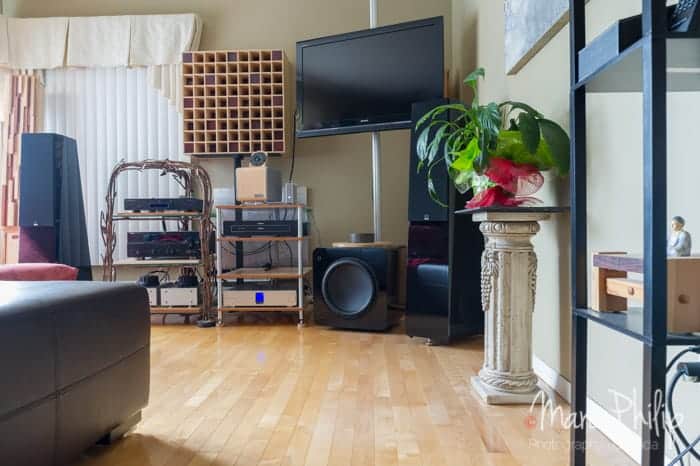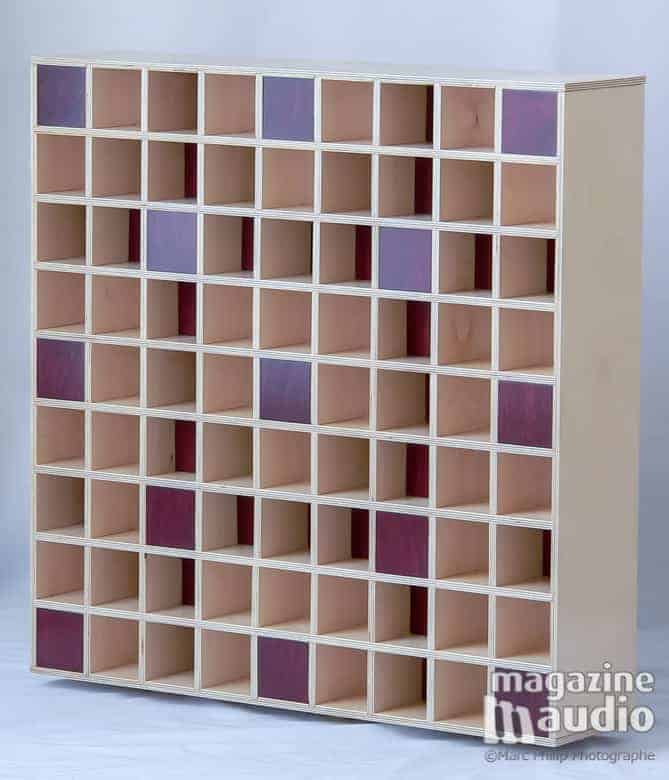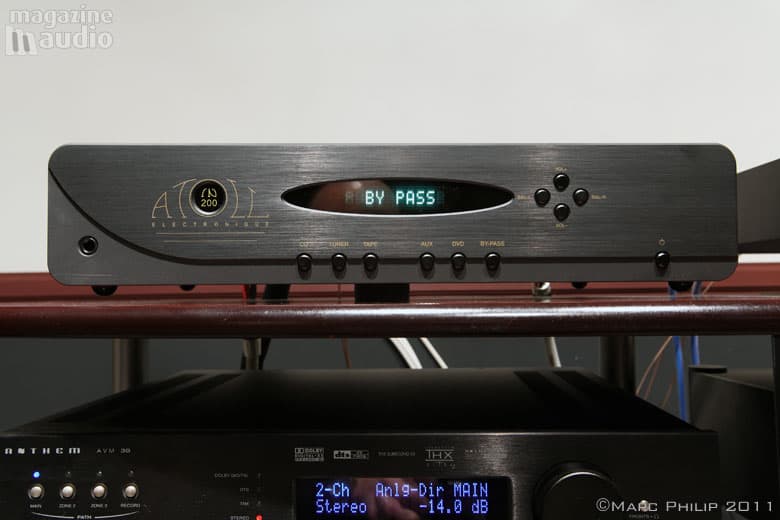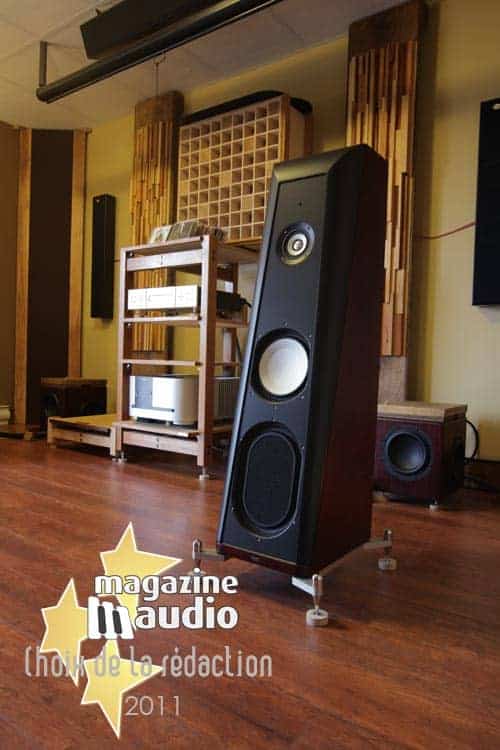Reviewer
Marc Philip, editor, magazine-audio.
Is there anyone who has never asked him or herself, « How would my system behave with better electronics? »
Or perhaps,
« … what does a high end preamp sound like? »
« … is a Class A amplifier really better than a Class AB? »
« … what difference does a power conditioner make? »
To answer these questions, we installed in our listening room, in the place of our reference, a completely different system lent to us by a local audiophile.
We knew this setup from previous sessions in our friend’s listening room with his speakers.
Now was our chance to find out how his electronics sounded in our own listening room.
System Components
Music Hall CD 25.2 digital transport, Sound Fusion Cd player shelves dedicated.
Bel Canto II digital converter
Melos SHA1 Studio Series vacuum tube preamplifier
Pass Aleph 5 amplifier, Class « A », 60 W / channel
PS Audio Power Plant 300 AC regenerator (500W maximum load)
Wireworld Stratus III AC cord on the converter. Stereovox HDXV digital interconnect.
Kimber Silver Streak interconnect with Eichman bullet plugs from converter to preamplifier via the amplifier.
Goertz Alpha Core MI 2 Veracity copper speaker cables with rhodium connectors. Wireworld Stratus III AC cord on the preamp.
XSymphony Precision One AC cord with gold Furutech connectors on the amplifier.
(This cord replaced a Wireworld Electra 5 with silver Leviton connectors, a cord which we thought imposed too much of its « own » character, forward in the high frequencies, and unbalanced the overall sound.)
XSymphony Triton Silver SE AC cord on the Music Hall transport and the PS Audio power conditioner.
Only the loudspeakers remained from our own system.
These are Monsoon FPF 1000 hybrid threeway units, upgraded with better crossover components (Mundorf Silver & Oil caps) mounted externally on triple points.
AC line treatment
Three dedicated circuits of BX 4 x 10 gauge cable run from the entry panel. Each line has its own breaker and is connected to a 20 amp double wall plug.
Our usual Furutech RTP6N box for the digital components was replaced here by the PS Audio Power Plant 300.
Audio supports and furniture
« Amadeus » tripod audio rack and shelves, Tripod steel & wood floor stands from the Marc Philip Design inovaudio™ line.
Sound Fusion Sound Fusion UNIVERSAL CD PLATFORM SF-79 advanced line of components and accessories.
Listening room.
4.9 metres x 3.53 metres (16 feet x 11.5 feet), painted gyproc (gypsum wallboard) walls and ceiling.
Acoustic treatment
inovaudio™ design type 2D horizontal and vertical diffuser panels
As a warmup, we thought it a good idea to take the time to get used again to the Goertz speaker cables, which replaced our own XSymphony Silvers.
The MI2 cables have a fairly high capacitance of 3535 pF, and they need an amplifier capable of driving such a load.
Our Crimson monoblocks could indeed take it, but curiously we heard something we had never heard before: voices were shifted towards the left of the soundstage.
We have no explanation for this.
The Goertz cables have their own signature, which you either enjoy or not. Their sound is soft and round, with no exaggeration, but they are most suitable for systems which need calming down at the high end and some help in the bass; this should enter into any purchasing decision.
There was absolutely no doubt about the difference in the sound reproduced by the two systems, using our Monsoon FPF 1000 hybrid speakers.
Having said that, what exactly was the difference?
Remember that with electronics of this quality the slightest change in setup is audible, so that a simple AC cord, a speaker cable or an interconnect swap will contribute its sonic « signature » and affect the fine tuning of the system. This is one way to achieve an impeccable setup, if an impeccable setup is what you desire.
The beauty of having high end electronics is that you can work on these little details and the results are audible; the effort is not in vain.
Further adjustment was not needed in the first hours after the system had been properly set up. All the same we placed the transport on a shelf made by Marlen Mogilever, director of R & D for Sound Fusion, a division of the Global Wood group.
This shelf is made up of two modules, the first of 2.7 cm (1 1/8″) plywood, with four brass and plastic cones set into the underside to provide coupling to ground. These four points rest on four Reference Vibe Boosf?ter I damping cups.
These damping cups are made of two different materials.
The centre is hard, to receive the point, and the periphery is soft, to provide damping.
A second shelf, made of acrylic 2 cm (3/4″) thick, sits on the wooden shelf, decoupled from it by four Reference Sound Booster III rubber pucks calibrated to accept the weight of a CD player.
The whole thing is a sort of monument dedicated to digital and is unpretentiously called a doublelevel CD platform.
In order to keep the system sounding as much as possible the way it did in its owner’s home, we kept the PS Audio power regenerator in the system, at the maker’s « SS1 » setting, which provides a stable 117 volts at 60 Hz followed by tow 120 Hz partial cycles.
We would see later on how the system behaved with the PS Audio Power Plant at different settings, and without it entirely.
Results
The difference we mentioned? A real improvement in two frequency ranges, the bass and the upper midrange.
The bass had new extension and firmness, voices were better defined and more natural.
The difference was flagrant as we went from one system to the other and back again.
The sound was less dry, smoother, and I loved the midrange, very natural with a nice height.
I’ve noticed in the past that missing detail seems to be the first thing we perceive in a comparative listening session.
For me anyway, going from a highperformance system to one a little less good is more revealing than going the other way.
I can evaluate an improvement and not just a difference.
The minuses
The extreme highs were slightly laid back, but this is being finicky.
Auditory memory being what it is, I am still thinking of our usual system as a reference.
We thought of trying something just to see what happened.
As we saw, the special shelves under the CD transport were in decoupling (soft) mode.
My idea: switch to coupled (hard) mode.
To do this, I removed the acrylic shelf and the four Sound Booster IIIs, then replaced the four Vibe Booster I cups with four aluminumandwood cups from our catalogue.
The transport thus was sitting on three Black Diamond Racing Cones with carbon supports Those Things.
As we have frequently observed, coupling is much more effective than decoupling under a CD player, yielding better definition and a less heavy, more articulate bass.
This setup put the bass and the lower mids on a muchneeded diet, which allowed the extreme highs to appear where they had been absent previously.
You read us right: decoupling supports under a CD player may well produce a rounder sound… a useful thing to know if that’s what you want.
To confirm our impression, we decided to test Mr. Mogilever’s shelf a little further by doing something he suggests: setting a Vibe Buster II or vibration hunter on top of the transport.
In fact we did get the best results with the Vibe Buster II on top of the CD transport, but without the Sound Fusion cups which cancelled some of the Vibe Busters’ effect.
Set up coupled/decoupled in this way, the CD player sounded more at ease.
We wind up with four inovaudio coupling cups (i.e. rigid links) made of solid wood with aluminum inserts.
The four points + wood shelf + four rubber decouplers + acrylic shelf + Vibe buster Sound Fusion on top of the CD transport.
Simply removing the Vibe Busters from this setup changed the bass response.
Keeping them or not was a question of taste. Some will like their full, ample low end and others will prefer a tighter bass with more slam, better defined and « cleaner ».
Whichever way you like it, the effect is there.
Upcoming tests
– The PS Audio Power Plant 300 and its different modes and settings,
– The system without the Power Plant 300,
– A different RCA interconnect from the preamp to the Pass power amp,
– The Melos preamp with the Crimson monoblocks,
– The Proceed player with the Melos preamp,
– The Proceed player with our Sima P2001 preamp and the Pass Aleph 5 amplifier,
– Whatever you’d like to try out if you were doing it with us, just ask.
Record listening to this session :
1 Chris Jones (No sanctuary here) 03:47,
2 Blues Company (Cold rain) 05:44,
3 France Gall (besoin de vous)Live Bercy 1993 03:36,
4 Oscar Peterson Trio “You look good to me” 04:47,
5 Monty Alexander Trio “Nite Mist Blues” 10:10,
6 Georgia on my mind (jazz vocal) 05:14,
7 Holly Cole (I can see clearly now) 04:13,
8 J.Strauss (Tik-Tak Polka-Orchestre Pasdeloup en Répétition) 03:54,
9 J.Terrasson (la Javanaise) 03:33,
10 Jheena Lodwick (FIM) (Do that to me one more time) 03:57,
11 Martin Xavier (Scene de la vie pastorale) 02:04,
12 Musica Nuda (How Insensitive) 02:36,
13 Patrick Husson (Casta Diva) 02:41,
14 Rachelle Ferrell (Prayer dance) Montreux 1991 06:31,
15 Sometimes I feel Like a motherless child (spiritual) 02:26,
16 Vincent Bidal trio (La boheme) 03:33,
17 Canon in D (Pechelbel) 06:43,
18 Clochettes et sonnailles 03:09.
Sound Fusion Inc.
1111 Flint Road, Unit 1,
Downsview, Ontario,
Canada M3J 3C7
Tel: 416-645-1726
Fax: 416-645-1727.
_____________________________________________
This article as been written by Marc Philip independent writter to www.magazine-audio.com, all rights reserved, copyright 2006, texts and photos are the property of the author.













